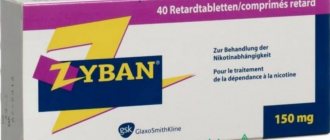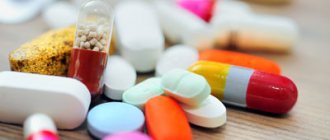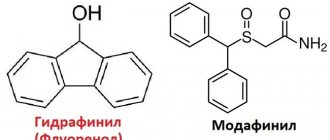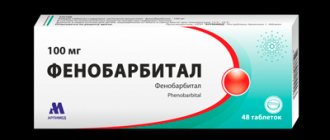For various problems with cerebral circulation, pathologies of the cardiovascular system and the central nervous system, there is a need to use nootropics.
One of the popular remedies is Gliatilin .
Compound
The basis of the composition is the chemical compound choline alphoscerate.
The area of action of the component extends to choline receptors in the central nervous system.
To ensure that the product is better absorbed by the body, the active ingredient is supplemented with:
- esithol;
- sodium ethyl parahydroxybenzoate;
- gelatin;
- sodium propyl parahydroxybenzoate;
- sorbitans;
- metahydroxide;
- titanium dioxide, iron.
To produce a liquid form, the active ingredient is supplemented with glycerin and liquid in the form of purified water.
Pharmacology
The therapeutic effect with high effectiveness is ensured due to the physical and chemical properties of the constituent chemical compounds.
Among the main ones:
- influence on systemic blood flow by accelerating blood circulation;
- activation of metabolic functions;
- stimulation of the reticular formation;
- restoration of lost functionality in case of various types of injuries (damage to brain tissue).
The nootropic corrects the factors of involutional psychoorganic syndrome.
This process is based on the suppression of cholinergic activity, as a result of which the amount of phospholipids in neuronal membranes changes.
Choline alfoscerate easily passes through the morphological structures of the brain, increasing the concentration of the active component mainly in the tissues of the brain, liver and lungs. Under the influence of metabolic processes, the substance is converted into carbon dioxide, after which it is excreted from the body through the intestines and kidneys.
Pharmacodynamics
Improves the transmission of nerve impulses in cholinergic neurons; has a positive effect on the plasticity of neuronal membranes and receptor function. Improves cerebral blood flow, enhances metabolic processes in the brain, activates the structures of the reticular formation of the brain and restores consciousness in case of traumatic brain injury.
It has a preventive and corrective effect on such pathogenetic factors of involutional psychoorganic syndrome as changes in the phospholipid composition of neuronal membranes and a decrease in cholinergic activity.
Experimental studies have shown that Gliatilin stimulates the dose-dependent release of acetylcholine under physiological conditions of neurotransmission.
When ingested, it is broken down by enzymes into choline and glycerophosphate.
Gliatilin, on the one hand, being a choline donor, increases the synthesis of acetylcholine and has a positive effect on neurotransmission, on the other hand, glycerophosphate is involved in the synthesis of phosphatidylcholine (membrane phospholipid), as a result, both have a positive effect on membrane elasticity and receptor function, which improves synaptic transmission.
Thus, pharmacodynamic studies have shown that Gliatilin acts on the synaptic, incl. cholinergic neurotransmission; plasticity of the neuronal membrane; receptor function.
Price and release forms
The cost of the medicine depends on the form of release and dosage:
- Capsules (400 mg, 14 pcs.) – price in the range 720-780 rub..
- Oral solution (600 mg/7 ml, 10 units) – price 520 rub..
- Injection liquid (1000 mg, 4 ml ampoules, 3 units) – price range 565-630 rub..
You can buy a nootropic drug both in a pharmacy chain and in an online store.
One of the main conditions for dispensing a pharmacological product is the availability of a prescription.
When placing an order through an online pharmacy, you have the option of purchasing the medicine without a prescription.
Composition and release form
| Capsules | 1 caps. |
| choline alfoscerate | 400 mg |
| excipients: purified water; glycerol | |
| capsule shell composition: gelatin; esitol; sorbitans; sodium ethyl parahydroxybenzoate; sodium propyl parahydroxybenzoate; titanium dioxide (E171); iron (III) metahydroxide (E172) |
in a blister pack 14 pcs.; in a cardboard pack 1 package.
| Solution for intravenous and intramuscular administration | 4 ml |
| choline alfoscerate | 1000 mg |
| inactive ingredient: water for injection |
in ampoules of 4 ml; in a blister pack there are 1 or 3 ampoules, in a cardboard pack there is 1 ampoules.
Indications for use
In medicine, nootropic medicine is used for the following pathologies:
- disturbances of visual memory, speech functions;
- syndromes characterized by a decrease in intelligence, memory and other degenerative damage (when the cause of their development is cerebrovascular insufficiency);
- decreased cognitive activity, dementia.
The drug is highly effective in correcting psycho-emotional states, behavioral disorders, and other central nervous system pathologies.
Gliatilin is included in complex therapy to eliminate the consequences that arise from traumatic brain injuries (in the acute phase), when the patient experiences loss of consciousness, a coma, and focal hemispheric symptoms.
Other uses of the medicine:
- for strokes to relieve acute symptoms;
- for rehabilitation after a stroke (promotes the restoration of physical skills and consciousness).
The neuroprotector is also used in therapy for children.
It is considered justified to use the medicine for the following problems:
- neuroses, nervous tics;
- autism;
- ADHD;
- hydrocephalic syndrome;
- cerebral palsy;
- with mental retardation, mental retardation;
- with birth injuries of the brain;
- during labor hypoxia.
Indications
acute period of TBI with a predominantly brain stem level of damage (impaired consciousness, coma, focal hemispheric symptoms, symptoms of brain stem damage);
ischemic (acute and recovery period) and hemorrhagic stroke (recovery period);
degenerative and involutional psychoorganic syndromes and consequences of cerebrovascular insufficiency, such as primary and secondary disorders of mnestic functions, characterized by memory impairment, confusion, disorientation, decreased motivation, initiative, and ability to concentrate;
changes in the emotional and behavioral sphere: emotional lability, increased irritability, decreased interest, senile pseudomelancholy;
multi-infarct dementia.
Instructions for use
The injection liquid is designed to administer medication using a needle via the IV or IM route.
Intravenous injections (droppers) are performed with preliminary dissolution of 1 ampoule of the drug with 50 ml of saline solution.
The speed of liquid movement through the system is 80 drops/min.
- Treatment of acute forms of diseases begins with intramuscular injections. The daily dose is 600-1000 mg. Sometimes it is rational to use intravenous medication (up to 3000 mg).
- As soon as there is a positive trend in the patient’s condition, a switch to tablets is made. This takes on average 5-10 days.
The development of a treatment regimen and determination of dosage is carried out exclusively by medical staff. The doctor also has the right to make adjustments to the treatment process if necessary.
The neuroprotector in capsules is taken orally. Taking time: 40-60 minutes before meals.
The treatment regimen involves taking the medicine 2-3 times, 1 tablet each, for 3-6 months (the duration of the course depends on the etiology of the disease, the intensity of its development, and the patient’s condition).
Instructions for use for children:
- It is better to take the medication in the morning before breakfast;
- You need to take the whole tablet only with purified water (100-150 ml);
- when prescribing intravenous drip infusions, the drug is pre-diluted with saline solution;
- IM injections are given into the muscle tissue (the shoulder or femoral part is most often involved);
- injection time – up to 12-14 hours.
For TBI, it is recommended to use 1 ampoule per day for 1 week. After this, a transition to capsules is made (1 unit twice a day for 2 months).
The duration of therapy for birth trauma/hypoxic encephalopathy is about six months. For 10-12 days, injections are given once a day (1-2 ml). The daily norm for children 1-3 years old can increase to 2-3 ml, for the age group over 3 years old - 4 ml. The next stage of therapy is the use of tablets. Capsules are used according to the following scheme: 1 pc. 2 times a day. After 2-3 months, treatment can be adjusted by a specialist under whose supervision the patient is.
Instructions for use of Gliatilin
The instructions recommend long-term use of the drug, since restoration of brain function takes time. The minimum course is 3 months. It can be extended up to six months. As a rule, patients are prescribed the drug in the form of capsules for oral administration. But due to the fact that the capsules themselves are quite large, not every patient can absorb them, for example:
- child;
- a patient with a swallowing reflex disorder;
- patients who have suffered an ischemic stroke with a high degree of severity of damage.
In addition, unconscious and comatose patients are also unable to swallow the drug. In such cases, an alternative is prescribed - a solution for drip administration. 1 ampoule is diluted with 50 ml of saline solution. The rate of administration is no more than 80 drops per minute.
When prescribing capsules containing 400 mg of the active substance, the course consists of two to three doses per day. The medicine should be taken after meals. Each capsule is covered with a dense layer of soluble shell, which protects the active components from the aggressive environment of gastric juice and duodenum. Once in the large intestine, the coating disintegrates and releases the drug, from where it is easily absorbed into the bloodstream and reaches the brain. Therefore, the idea of cutting the capsule and squeezing the contents into a puree-like food to make it easier to take is impractical. The acidic environment of the stomach will destroy all the benefits of the substance.
Side effects
In the course of a study conducted to study the effect of choline alfoscerate on the human body, rare cases of side effects were identified.
At the initial stage of therapy, nausea, mild confusion, and epigastric pain may appear.
The doctor who is seeing the patient is informed about unpleasant symptoms. The specialist will adjust the dose, select an analogue, and make other changes to the treatment course.
Indications for the use of Gliatilin
Gliatilin is prescribed for diagnosed disorders of the blood supply to the brain, which can be manifested by confusion, memory loss and other typical symptoms. Diseases and conditions that are direct indications for taking the drug:
- traumatic brain injuries leading to impaired consciousness, post-traumatic coma, dizziness;
- ischemic stroke, leading to necrosis of parts of the brain;
- dementia;
- age-related speech disorders;
- bouts of disorientation.
Patients taking gliatilin for long courses showed improvement in their condition, restoration of thought processes, and return of memory.
Patient reviews
Albina:
I came across a lot of information about the drug Gliatilin on the forums, but reviews for children are sparsely presented. I decided to share my experience of using a nootropic, which I gave to my child for neurosis. Therapy lasted 4 months (1 capsule per day). Positive dynamics became noticeable after 10 days.
A month later, the child looked absolutely balanced, despite the not always adequate behavior towards him of his peers. I did not observe any side effects throughout the treatment period.
Victor, 37 years old:
After a TBI at the plant, he underwent serious treatment using several drugs. Gliatilin was prescribed to restore lost physical skills and cognitive processes. After a couple of weeks, I felt the first improvements: irritability disappeared, speech became clear and understandable, and concentration increased. No side effects were observed when using the capsules.
Reviews from neurologists
A. P. Stepanov, work experience 22 years:
Gliatilin shows high effectiveness in therapy after stroke attacks, TBI, and CVD. In combination with other pharmacological agents, it is possible to quickly restore lost functionality and cope with disturbances in the blood circulation of the brain. Long-term use of the drug reduces cognitive deficits.
Features of using the nootropic: due to increased excitability, it is recommended to take it before lunch time to avoid negative effects on healthy sleep. Efficiency increases with course therapy, which involves the use of injections at the initial stage, then capsules.
Tatyana Mikhailovna Kuznetsova, practicing specialist with 12 years of experience:
Gliatilin is an effective neuroprotector, as proven by reviews from adults on forums. The opinions of doctors who use psychotropic drugs in their practice do not disagree with them. A high therapeutic effect is achieved with asthenia, VSD, cerebral palsy, etc.
The availability of different forms of release is also considered convenient, which allows you to achieve the desired result with minimal stress on the liver and kidneys.
Analogues of the drug
Any drug that is developed based on choline alfoscerate is hypothetically suitable for therapy.
In fact, a specialist chooses an analogue taking into account several important factors.
The most effective medications are:
- Cerepro;
- Nooholin Rompharm;
- Delecite;
- Cereton;
- Holitylin;
- Gleazer.
For children, the doctor suggests:
- Anvifen (capsules) – recommended from 3 years of age, active substance – aminophenylbutyric acid;
- Cortexin (in injection ampoules) – can be included in therapy for premature babies;
- Aminalon (in tablets) – the composition contains GABA, used from 1 year;
- Pantogam (in the form of syrup) - the composition is based on hopantenic acid, the drug is suitable for any age;
- Nootropil (various forms) - the composition is developed on the basis of piracetam, used from the age of one.
The selection of an analogue is carried out by a qualified specialist who takes into account the properties of the medicine and its area of influence on the health of a particular patient.








